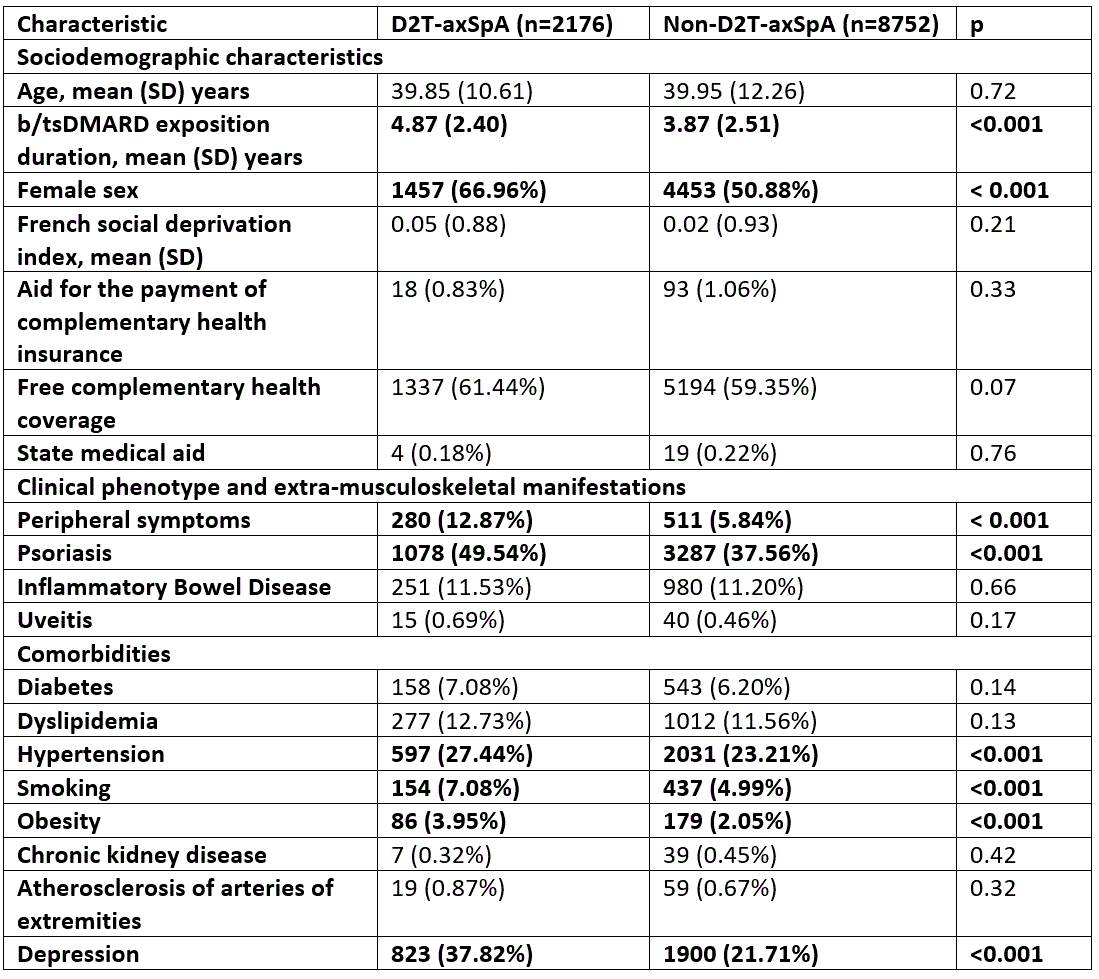Session Information
Date: Sunday, November 12, 2023
Title: (0510–0542) Spondyloarthritis Including Psoriatic Arthritis – Treatment: AxSpA Poster I
Session Type: Poster Session A
Session Time: 9:00AM-11:00AM
Background/Purpose: An increasing number of targeted therapies are available for the treatment of SpA. However, some patients retain active disease despite several lines of treatment. This has led to the emergence of the concept of difficult-to-treat axial SpA (D2T-axSpA), inspired by similar reasoning in rheumatoid arthritis (D2T-RA). This study aimed to determine the cumulative incidence and identify the factors associated with D2T-axSpA.
Methods: This study used the French National Medico-Administrative Database Système National des Données de Santé (SNDS), which includes administrative data, long-term illnesses (LTIs), outpatient care, medication consumption, and hospitalizations for 97% of the French population. All patients newly benefiting from the LTI #27 “severe spondyloarthritis” with associated diagnostic code M45 (AS), between 2010 and 2013, were included. The use of LTI allowed us to build a cohort of patients with supposedly active disease, the SNDS having no data on disease activity. All patients with active SpA despite NSAID treatment and therefore requiring DMARDs were theoretically newly enrolled in the LTI scheme. The end date of follow-up was December 31, 2018.
Similar to the EULAR definition of D2T-RA, D2T-axSpA was defined as the failure of three biologic/targeted synthetic DMARDs (b/tsDMARDs) or two b/tsDMARDs with different modes of action. Comorbidities and extra-musculoskeletal manifestations (EMM) were identified using previously described algorithms.
A comparison of characteristics between the D2T-axSpA and non-D2T-axSpA groups was performed using t-tests for quantitative variables, and Chi-2 for qualitative variables. Multivariate analysis adjusted for age and b/tsDMARD exposure duration was performed using logistic regression analysis.
Results: 23062 patients were included. 10928 (47.39%) patients received at least one b/tsDMARD during the study period. Uveitis was observed in 82 (0.36 %) patients. This can be explained by the algorithm used, which detects only hospitalized patients. There was also a lack of sensitivity for the detection of smoking and obesity. The rates of other comorbidities and EMM were similar to those reported in previous studies.
During follow-up, 2176 were classified as D2T-axSpA, representing 9.44% of all patients and 19.91% of patients who received at least one b/tsDMARD. To limit selection bias, comparisons were restricted to D2T-axSpA and non-D2T-axSpA patients who had received at least one b/tsDMARD. In the univariate analysis, peripheral involvement and psoriasis were significantly more frequent in the D2T-axSpA group (Table 1). There was a significant increase in smoking, obesity, hypertension, and depression in the D2T-axSpA group. These results were confirmed by the multivariate analysis, with the highest OR for peripheral symptoms (Table 2). Analyses restricted to patients fulfilling the definition of D2T-axSpA over a maximum period of 2 years showed similar results (data not shown).
Conclusion: D2T-axSpA affects one in five patients exposed to b/tsDMARDs in this national cohort. D2T-axSpA is more common in women and in patients with peripheral involvement, psoriasis, and depression.
To cite this abstract in AMA style:
FAKIH O, Desmarets M, Martin B, Prati C, Monnet E, Wendling D, Verhoeven f. Difficult-to-treat Axial Spondyloarthritis Is Associated with Psoriasis and Comorbidities: Results from a Nationwide Study [abstract]. Arthritis Rheumatol. 2023; 75 (suppl 9). https://acrabstracts.org/abstract/difficult-to-treat-axial-spondyloarthritis-is-associated-with-psoriasis-and-comorbidities-results-from-a-nationwide-study/. Accessed .« Back to ACR Convergence 2023
ACR Meeting Abstracts - https://acrabstracts.org/abstract/difficult-to-treat-axial-spondyloarthritis-is-associated-with-psoriasis-and-comorbidities-results-from-a-nationwide-study/


